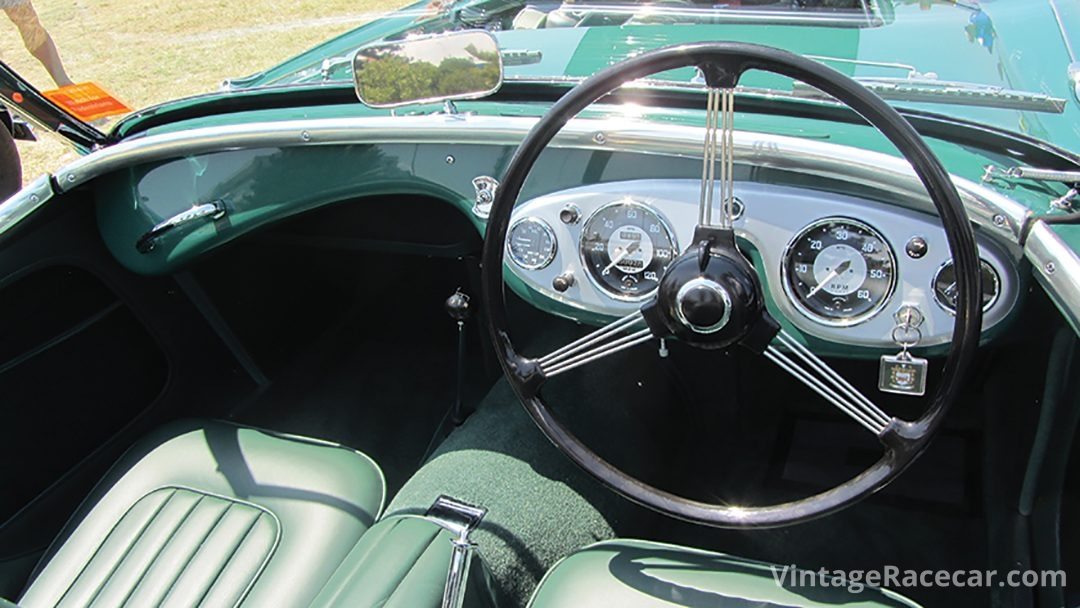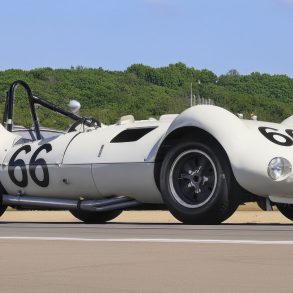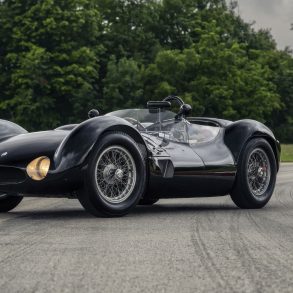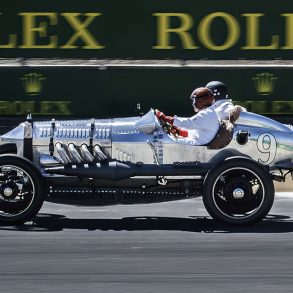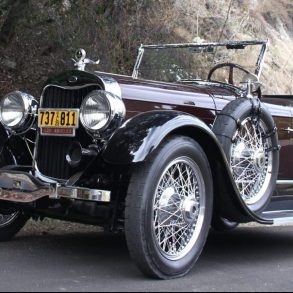You know how the saying goes? “Wish I had a dollar for every time I heard that.”
The scene was the 1952 London Motor Show with a number of new cars on display including the Morris Minor SII, Bentley Continental R-Type and the Standard-Triumph TR sports car. Arriving late on press day, after nearly missing out on the pre-show festivities, the Donald Healey Motor Company sneaked its new sports car, the Healey 100 into the hall. It was faced towards a pillar, away from view, as Donald Healey didn’t think the grille looked right. Along came the boss of the newly formed British Motor Corporation, Leonard Lord, who said something like, “By Jove, what a lovely looking sports car and look! It has an Austin engine and gearbox. What a surprise! Mr. Healey let’s go to dinner and discuss making a deal. We’ll build the ‘100’ in our factories, and sell it across the world through our sales organization.”
Well not quite, as Lord while being BMC El Supremo, had come from Austin and that’s where his heart lay. He was well aware of plans afoot, with MG preparing a replacement for the square rigged T series, the car that eventually became the MGA. Plus Lord had been trying to make good the sales disaster of the Austin A90 Atlantic, which resulted in a surplus of 2.6 liter four-cylinder engines and gearboxes. So he let be known, through the close knit British automotive manufacturing industry, that he was interested in one of the smaller companies designing a new sports car using Austin mechanicals to compete against the MG.
Three different companies took up the project namely Frazer Nash, Jensen Motors and the Donald Healey Motor Company. Each built cars, but of the three, the Healey 100 came the closest to Lord’s brief, by using all A90 mechanical components. It is also true that it had been on Donald Healey’s mind that there was a gap in the sports car market between the Jaguar XK and the T Series MG.
Prior to the Motor Show, while Donald Healey had met with Lord about the car, discussions had not led to the result Healey wanted. At the Motor Show, Donald Healey and his staff had trouble keeping people away from the stand and within a short period of time Healey had received two offers of co-operation to manufacturer the new 100. Healey never let on who the others were. The car’s wonderful reception brought on Lord’s announcement that Austin was to build this new graceful sportscar and it would be available from Austin dealers throughout the world. What is true was that Lord did see the car at the Motor Show and, yes, he and Healey did have dinner and overnight the Healey 100 became the Austin-Healey 100.
Production
While the first 20 were made by the Donald Healey Motor Company in Warwick, production got into full swing in June 1953. Jensen Motors ended up with the contract to produce the car which was delivered complete with trim to Austin’s Longbridge plant for the installation of the mechanicals.
Between the London Motor Show and the start of production over 3,000 orders had been received for new Austin-Healey 100s and it wasn’t until 1954 when all orders were satisfied. Then it was a further 12 months, before you could walk into a showroom and expect to drive away in a new car.
At 2,150-lbs it was a reasonably light motor car and while 90 bhp doesn’t sound like much today the amount of torque produced by the 2.6 liter, four-cylinder engine was prodigious meaning that it was possible to stay in the higher gears and overdrive.
However, what must be made mention of is the gearbox fitted to the 100 had its origins in the A90 Atlantic. In A90, form it was a four-speed, but that car weighed 850 pounds more. This in effect meant that first gear was too low when fitted to the 100 so the simple solution was to install a blocking plate to the selector mechanism that while the four gears were inside the gearbox, only the top three could be used. This caused quite a few problems with buyers, resulting in a very large number of warranty claims.
The BN1 was replaced in August 1955 by the 100 BN2 which was fitted with a true four-speed gearbox and overdrive.
Driving
Driving an Austin-Healey 100, back in the mid-1950s, must have been a mind-changing experience when you compare it with most other cars of the period. This was a 100 mph car when new, while most others were pushing to get past 60. Available in period was quite a range of performance parts ranging from bigger carburetors, camshafts, larger fuel tanks and differential ratios. Plus, if you wanted to get the lot, a Le Mans kit was available to aspiring racers on road or track.
Our test car is an early 1955 example that has been restored to concours gold level standard. Sitting in its driver’s seat takes you straight back to the 1950s, with all the instruments needed including tachometer, speedometer, fuel gauge and a combined oil pressure/water temperature. The tach is red lined at 4,700 which isn’t high, but it’s not an engine that thrives on revs as it’s the torque that counts.
Turn the ignition key, push the starter button, push the mechanically operated clutch and into first. But where is first? The three-speed box shows its column-shift origins as the gearstick comes from the left-hand side of the gearbox. The shift is opposite to the normal with reverse back and to the right. First is also back and a little to the left and second is up, left and then up again while top is straight back from there. Then there is the overdrive that operates on second and third by a switch on the dash.
Having just three speeds is no drawback because with that torque, second gear seems to go on forever and there is overdrive still to go. Top can be selected almost from a walking speed and take you all the way. Plus, selecting overdrive as you accelerate past that MX-5 is a real joy that has to be experienced.
While all Austin-Healeys are appreciating in price, the four-cylinder cars are accelerating at a greater rate. There were only 10,010 BN1s made and to many its styling represents the epitome of the 1950s sports car.
Specifications
Production May 1953 – August 1955 • Chassis/Body Box section steel with alloy/steel body • Wheelbase 90in/2,290mm • Length 151in/3,830mm • Width 60.5in/1,540mm • Front & Rear Track (F) 49in/1,240mm (R) 50.75in/1,290mm • Weight 2,150lbs/975 kilos • Suspension (F) Coil sprung independent, wishbones, lever-arm shocks and anti-roll bar (R) Live axle, semi-elliptic leaf springs, Panhard rod and lever-arm shocks • Engine Cast Iron straight-four • Displacement 2,660cc • Bore x Stroke 87.3 x 111.1mm • Compression Ratio 7.5:1 • Induction 2 SU H4 carburettors • Power 90bhp @ 4,000rpm • Torque 144lb/ft @ 2,000rpm • Transmission 3-speed manual with synchro on all plus overdrive • Brakes Drums – Front & Rear
Performance
op Speed 103+ mph • 0-60 mph 11.7 secs • Average Fuel Consumption 22.5 mpg (imp)
Valuation
Price at Launch $2,985 • Excellent $70,000 • Good $40,000 • Average $25,000 • Poor $12,000




